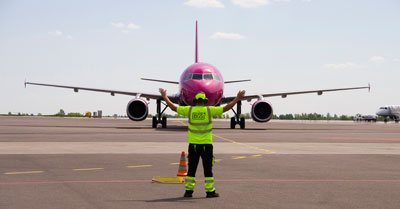Airlines push ground handlers to cut turnaround times and open up to new technologies
 The gap between low cost and traditional air carriers is narrowing firmly. This fact alone puts pressure on ground handling (GH) companies as well. Although, there are airlines that inquire for 40-60 minutes service, the share of air carriers asking for 20-30 minutes turnaround time review is expanding firmly, even though, they are not LCCs. Increased speed and scope demand foster GH to either hire more people or look for other efficiency-oriented alternatives, for example, IT solutions that help to plan in advance and save costs.
The gap between low cost and traditional air carriers is narrowing firmly. This fact alone puts pressure on ground handling (GH) companies as well. Although, there are airlines that inquire for 40-60 minutes service, the share of air carriers asking for 20-30 minutes turnaround time review is expanding firmly, even though, they are not LCCs. Increased speed and scope demand foster GH to either hire more people or look for other efficiency-oriented alternatives, for example, IT solutions that help to plan in advance and save costs.
Due to increasing need for air travel, airlines‘ aircraft fleet expansion and in general, intensified number of flights, industry is increasingly demanding for growth. Airlines not only hire more employees but also increase the efficiency of aircraft fleet usage. Traditional airlines operating medium-haul routes approximately fly 7-14 hours a day. In contrast, LCCs aiming to maximize the aircraft fleet efficiency, implement intensive short-haul schedules which sometimes can even double the flying time compared to the industry’s average. The intensity of flights complicates GH service provision – clients require fast, though frequent service. Increasing competition now separates GH companies as well: those that adapt and find solutions to remain financially stable and competitive as well as those that fail to adapt to growing needs.
“GH industry, in general, is conservative, sticking to legacy IT solutions, in contrast, airlines are moving way ahead rapidly. It became all about the efficiency and maximization of current resources – air carriers require quick service at lower costs which is impossible to reach using 20th century technologies. We have spotted the changing market tendencies ourselves and have started looking for some smart IT solution that would assist in optimal decision making,” comments Gytis Gumuliauskas, CEO of BGS. “Intensive flight schedules require precision and rational planning of people, their training, tariff control, contract administration and in our case, additionally fuel logistics. All these tasks become undermined when thousands of people are involved – it simply provides room for human mistakes. This is a fierce risk that Sensus Aero solution helped us to minimize significantly.”
Fulfilling the demand – it is not necessarily about more employees

It is natural in business that growing demand alerts success and consequently, more personnel. However, increasing number of employees is not necessarily the most optimal solution. In the last few years, employment in aviation industry in the USA has fallen by 2.4%. The decline was contributed by mergers and acquisitions of airlines, but as research of Bureau of Transportation Statistics (BTS) shows, digitalization of planning has contributed significantly as well. The decreased employment is seen to be correlated with the records of passengers handled and at the same time increased profitability in the USA aviation industry’s case.
Working under strict certification policy, such companies as BGS are especially concerned about the qualitative features, such as training, for example, of employed personnel. Poor training planning or mismatched certification expirations lead to either trouble with authorities during audits or delays to provide service which consequently can lead to losses of thousands or hundreds of thousands euros. In contrast, systemized digital solution displays the big picture of training demand, schedule reminders and organize training optimally for larger groups. For BGS, implementation of Sensus Aero saves at least 8 hours of HR manager’s time per week and decreases training costs up to 15% per year.
Administrative ghosts of the past
On average, in GH industry, 10-15% of all services provided are not listed on the final invoice sheet due to unintentional human mistakes. This happens due to complexity of diverse tariffs for 16 stations and 30 clients for BGS as an example. In GH, confused monetary contract detail can lead to the loss of 5-10% of the contract revenue. However, operation management solutions help to control the process and employee inattention. For BGS, Sensus Aero, web-based and cloud-enabled IT solution, has helped to decrease the invoicing errors by 98% per year.
“When business is rapidly expanding, operations integrity is a must to ensure quality. Regular operation management solutions usually require local system installation, procurement of licenses separately for each new location and recruitment of people to administrate it. Such specificities for us were the stumbling blocks translating into enormous expenses while developing BGS business in new locations. A common flexible operation management solution allows transferring not only time-tested business model and processes, but also customizing the solution depending on local authorities rules easily. It has helped us to save at least 2-3 times in comparison to other alternatives.” adds Gytis.
Highest quality standards made possible
Most airlines’ on-time performance KPI is 98%, in contrast to GH industry that usually operates under higher internal KPIs, in BGS case 99.2%. The exalted internal quality control is a consequence of the industry’s pressure discussed. Well-developed quality module contributes to high inner rate support and in general, achieving quality standards. Accelerated processing of delay codes, their categorization, investigation and corrective action undertake are just a few facilitations that assist remaining competitive in the market. It simply helps to foresee the alerting situations and act with accordance in the future.
Finally, such digital operations management solutions can become a rational tool to fulfill the growing demand optimally. Business case analysis of BGS reveals that while employing operation management solutions, and working with the same amount of resources, company can serve at least 10-15% of extra flights per year. At the end of the day, this fact alone only confirms that there exists other than increasing the number of personnel solutions that help to assist exploiting business opportunity.





